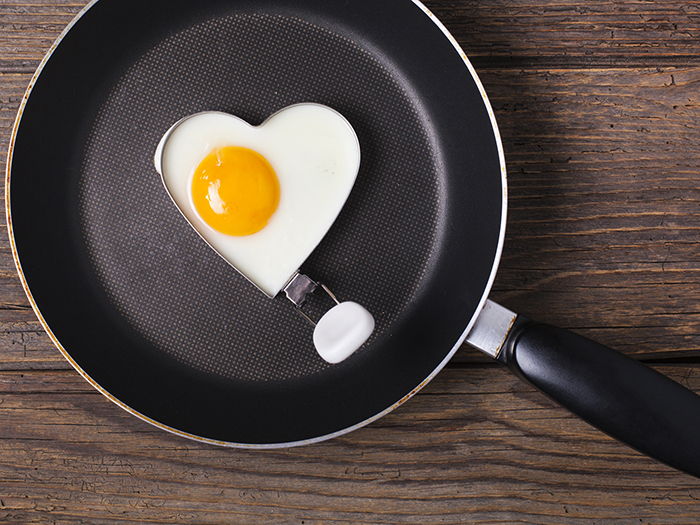8 Things You Don’t Know About Cholesterol — but Need To
Many dangerous myths persist about this blood fat. Here, we clear them up—because your health depends on it.

You’d think we’d all understand cholesterol by now, because many foods we eat every day contain it. But doctors say that’s not the case. In fact, many dangerous myths about cholesterol persist.
Cholesterol is a waxy, fatty substance that travels through your bloodstream. It’s also known as a blood fat. Your body needs some cholesterol for your overall health, but too much of it can put you at risk for heart disease and other illnesses.
If you’re 65 or older, your doctor has likely recommended screening every 4 to 6 years or even put you on a cholesterol-lowering medication.
Below, we set the record straight with eight important—yet not-so-well-known—facts about this blood fat.
Get and stay fit with SilverSneakers! Choose from dozens of different Community classes, visit a participating fitness location, or join one of 20+ SilverSneakers LIVE online classes. Check your eligibility here.
1. Cholesterol Is Important to Your Health
While too much raises your chances of having a heart attack, some cholesterol actually serves important functions.
“Cholesterol is essential to various body functions,” says Amgad N. Makaryus, M.D., an associate professor at Hofstra Northwell School of Medicine and chairman of cardiac care at Nassau University Medical Center.
It insulates nerve cells in the brain and plays a role in the structure and makeup of cell membranes. Your body also needs the blood fat to make vitamin D, certain hormones, and some enzymes that help break down food.
Cholesterol is carried through the bloodstream by two types of particles: low-density lipoproteins (LDL) and high-density lipoproteins (HDL).
LDL is often called the “bad” kind because it deposits plaque in the arteries, Dr. Makaryus explains. HDL, on the other hand, is often called “good” because its job is to take excess cholesterol out of your arteries and shunt it to the liver, where it can be broken down.
You’ll want to pay attention to all your cholesterol numbers — HDL, LDL, and total cholesterol.
Talk to your doctor about getting your levels checked and how those numbers affect your health. In general, the National Heart, Lung, and Blood Institute recommends:
- Total cholesterol: Less than 200 mg/dL
- LDL cholesterol: Less than 100 mg/dL
- HDL cholesterol: 60 mg/dL or higher
2. Some High-Cholesterol Foods Are Good for You
Unless you’re allergic or your doctor has specifically told you otherwise, go ahead and enjoy eggs.
“It’s true that eggs and shrimp contain a lot of dietary cholesterol, but dietary cholesterol isn’t nearly as dangerous as was once thought,” Dr. Makaryus says. “Only some of the cholesterol in food ends up in your bloodstream, and if dietary cholesterol intake rises, the body generally compensates by producing less cholesterol of its own.”
While you don’t want to overdo it with high-cholesterol foods, Dr. Makaryus adds, eating eggs, shrimp (and other shellfish), and full-fat yogurt and cheese a few times a week is not dangerous.
Recommended reading: The 5 Healthiest Full-Fat Foods, According to Dietitians
3. Saturated and Trans Fats Hurt Your Health
While eating some cholesterol-containing foods might not raise your numbers, getting too much saturated fat — found in butter, cheese, red meat, and other animal products — will.
“Strong evidence indicates that saturated fat in the diet is associated with increased total and LDL cholesterol, and increased risk of cardiovascular disease,” says Ginger Hultin, R.D.N., a Seattle-based dietitian and spokesperson for the Academy of Nutrition and Dietetics.
Less than 10 percent of your calories each day should come from saturated fats, according to the current Dietary Guidelines for Americans. To lower cholesterol, the American Heart Association recommends limiting it to 6 percent of your daily calories.
Meanwhile, you should consider trans fats totally off limits. They’re especially harmful because they raise LDL while also lowering HDL. In fact, the Food and Drug Administration (FDA) has determined that eliminating trans fats could prevent “thousands of heart attacks and deaths each year.”
Good to know: The FDA has banned trans fats in the U.S., but some foods may still have them. If a product has less than 0.5 grams of trans fats, it can still be listed as 0 grams on the label. To be safe, make sure you check the ingredients label for the term “partially hydrogenated” vegetable oil — this means the item has trans fats.
4. Sugar Also Messes With Cholesterol
Fats might seem like the biggest dietary demons, but carbohydrate intake is another crucial factor.
“Cutting saturated and trans fats is important, but if you’re replacing them with foods that are high in sugar and processed or refined carbohydrates — think soda, candy, baked goods — then you may still struggle with cholesterol levels and an increased cardiovascular disease risk,” Hultin says.
Some research suggests that sugar may be just as dangerous for your heart as saturated fat — or perhaps even more so. In fact, a diet high in sugar makes you 3 times more likely to develop cardiovascular disease, according to a 2016 study in the journal Progress of Cardiovascular Diseases.
Good news: These tips for clean eating can help you cut back on saturated fat, added sugar, and hidden sources of trans fat. You’ll not only help your heart. You’ll also boost your energy.
5. You Don’t Have to Be Overweight to Have a Cholesterol Problem
It’s true that high cholesterol and obesity often go hand in hand. If your doctor has diagnosed you as overweight or having obesity, “losing about 5 to 10 percent of your weight can significantly reduce blood cholesterol,” Dr. Makaryus says.
For someone who is 200 pounds, 5 percent is 10 pounds. Tip: Skip the crash diet, and check out the best way to lose weight after age 60.
What if you’re at a relatively healthy weight? Unfortunately, you may still have cholesterol issues. Certain factors, such as genetics and family history, may cause cholesterol levels to be high at any weight, Dr. Makaryus says. That’s why it’s important to get your cholesterol checked as recommended by your doctor.
6. Exercise Raises Good Cholesterol
If your doctor has told you that your cholesterol levels need improvement, lifestyle changes are key. Cardio exercise helps raise HDL (good) cholesterol, making it one of the most important healthy habits for cholesterol control, Dr. Makaryus says.
Subscribe to our newsletter
It's quick and easy. You could be one of the 13 million people who are eligible.
Already a member? Click to discover our 15,000+ participating locations.
Follow Us
Aim for 150 minutes of moderate–intensity exercise per week. Keep in mind that moderate-intensity activity means you will be able to talk but not sing.
Pick a workout you enjoy like going for a brisk walk or taking a SilverSneakers Circuit or Zumba Gold fitness class. (SilverSneakers members enjoy unlimited access to gyms and fitness classes nationwide. Check your eligibility here, or find a location here.)
That’s just the tip of the iceberg when it comes to how regular exercise improves your life. Check out 17 more ways your body and brain will change for the better.
Depending on your numbers and other risk factors for heart disease, your doctor may also prescribe cholesterol-lowering medications. Along with heart-healthy foods and exercise, medication can make a big difference.
7. Fiber Can Lower Bad Cholesterol
“Some foods absolutely do affect your cholesterol for the better,” says Hultin. Oats, beans, flaxseeds, whole grains, fruits, and vegetables are helpful because they’re high in fiber.
“Fiber molecules actually bind to cholesterol molecules and escort them out of the body via the digestive system,” she explains.
But you can’t just have a bowl of oatmeal for breakfast and eat tons of fast food and sweets the rest of the day. “People need to take a more holistic approach,” she says. “What is your general diet like—the collection of foods you eat each day?”
While there are a number of different heart-healthy eating plans, like the Mediterranean diet or DASH diet, they all tend to have a few things in common:
- Plenty of produce and whole grains
- Some lean protein, like poultry and fish
- Not too much added sugar or saturated fat
8. If You Smoke, Quitting Will Improve Your HDL
Quitting tobacco use will not only help your lungs, but it may also give your HDL (good cholesterol) a much-needed boost. Tobacco has chemicals that actively lower your good cholesterol.
That’s not all. Quitting also lowers your risk of a heart attack and stroke.That’s because smoking raises your blood pressure and can cause blood clots. When you stop using tobacco, you’re getting rid of a big risk factor of cardiovascular disease.
No matter your age or how long you’ve been smoking, there’s no time like now to stop. If you smoke, ask your doctor for help quitting, which can greatly increase your chances of success. Plus, make sure to read this guide to smoking myths you may still believe.
See our sources:
Cholesterol testing: Centers for Disease Control and Prevention
Cholesterol facts: National Heart, Lung, and Blood Institute
Cholesterol and your heart health: National Heart, Lung, and Blood Institute
Dietary Guidelines for Americans, 2020-2025: U.S. Department of Agriculture
Saturated fat and your heart health: American Heart Association
Trans fat and your heart health: Mayo Clinic
Saturated fat, sugar, and heart disease: Progress of Cardiovascular Diseases
Exercise guidelines: U.S. Department of Health and Human Services
Check Your SilverSneakers Eligibility Instantly
SilverSneakers members can go to thousands of gyms and fitness locations across the nation, plus take exercise classes designed for seniors and led by supportive instructors. If you have a Medicare Plan, it may include SilverSneakers—at no additional cost. Check your eligibility instantly here.
Already a member? Get your SilverSneakers member ID and exclusive fitness content by logging in to or creating your online account here.




